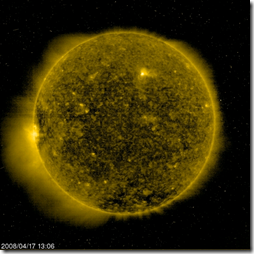Solar Measurements -- What do they mean?
 It's been so long since I've paid any attention to the sunspot and solar flux numbers, I've forgotten what they all mean. Pulling out some the references in the drawer revealed some simple applications of the numbers.
It's been so long since I've paid any attention to the sunspot and solar flux numbers, I've forgotten what they all mean. Pulling out some the references in the drawer revealed some simple applications of the numbers.
Sunspot measurement
Sunspot numbers are shown as a "tens" number relating to the number of "regions" on the site and a "singles" number relating to the number of sunspots associated with a "region."
So if there are no sunspots, the number is understandably zero. But, a single sunspot on the sun would translate into a sunspot number of 11. The tens spot for having one region and the singles number for one sunspot in the region.
Solar Flux measurement
Solar Flux is the 10.7 cm measurement from the daily 1700Z value recorded at Ottawa, Ontario. The solar flux varies from 66 -- the lowest number associated with zero sunspots -- to several hundred. It is a more "linear" view of sunspot numbers.
A very small change in the solar flux can have a big change in propagation. For example, here at the low of the sunspot cycle, a solar flux moving from 66 to 72 could mean longer openings on 20-meters until after sunset or even some 15-meter openings during the day.
An 80 reading will mean that 15-meters should open.
A 90 reading will mean that 10-meters should be open.
The A index
The A index is the measure of the geomagnetic activity or radio absorption of the ionosphere. The higher the A index, the more absorption and the weaker the radio signals. The A index range is near zero to several hundred.
As "rules of thumb," readings below 10-15 usually signify good band conditions. Readings over 30 usually mean bad band conditions.
The K index
The K index also measures radio absorption like the A index, but it is reported every 3-hours instead of every 24. Consequently, the K index more accurately reflects current band conditions than the daily A index.
The K index varies from 0 to 9, with 0-2 suggesting reasonably good conditions. The higher the number, the more absorption from disturbed conditions will exist.
Solar flux and A-K indexes work together
You always want low absorption on the bands, regardless of the solar sunspots.
The reason is that 160 and 80 meters perform very well with low sunspot numbers and low absorption, but aren't very good with high absorption.
Yet 10 meters can be fabulous with a solar flux of 110 and low absorption and terrible if the K index and the associated absorption is 9.
So you always want low absorption, regardless of the sunspot number.
Propagation is not an exact science. There are weird anomalies all over the place all the time (which is one of the reasons ham radio is so much fun). These numbers should provide some good guidelines, however, to get you used to looking at those solar numbers again now that the new solar cycle 24 has started.
Scot, K9JY